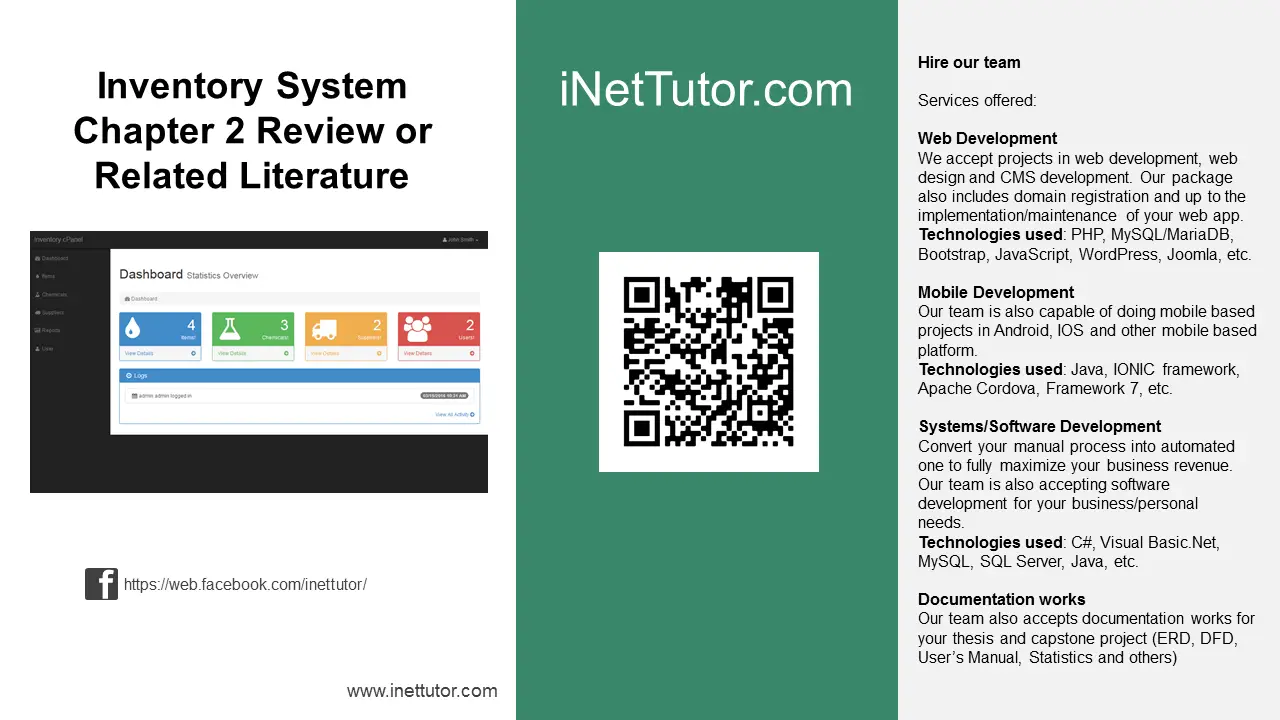Inventory System Chapter 2 Review or Related Literature
CHAPTER II
REVIEW OF RELATED LITERATURE / SYSTEM
This chapter discusses the related literature and studies which are related to the proposed study. It consists of review about the related concepts such as Information System, Management information System and Inventory System that may help the researcher develop and understand more their proposed study.
Information System
Shelly, Cashman, and Rosenblatt (2006) defined information system as a system that combines information technology, people, and data to support business needs. According to them, an information system has five key components, which are the hardware and software used, data, the processes performed, and the people involved. Everything in the physical layer of the information system is called hardware. Hardware includes servers, workstations, networks, telecommunication equipments, fiber-optic cables, handheld computers, scanners, digital capture devices, and other technology-based infrastructures.

Programs that control and manage the hardware components and produce the desired information or results are called software. Software can manage a single workstation or global network with thousands of clients. Examples of system software include the operating system, security software, device drivers, and utility programs. Data are raw materials in which are transformed into useful information. Information systems can extract specific information in various locations, such as tables, where data is stored (Shelly, et al., 2006). The building blocks of the information system are the processes. Shelly, et al. (2006) described process as the tasks and business functions that users, managers, and IT staff members perform to achieve specific results. Information systems are created to provide valuable information to users.
Management Information System
MIS or Management Information Systems “generate information for monitoring
performance and maintaining coordination.” (Key System Applications in the Organization, n.d.) This means that the administration of the company (at any level, meaning top management or middle management) monitors the information coming in and going out from the office through the use of a management information system. Since the company has several branches around, their MIS must give the management (even if an officer isn’t on the main office) the ability to view information flow on all outlets.(http://princessitas.wikispaces.com)
Inventory System
The following statements given are related to our study about the inventory system which is found very useful for the proponents in making the system.
“It is nearly impossible to overemphasize the importance of keeping inventory levels under control,” Ronald Pachura wrote in an article for IIE Solutions. “Whether the problems incurred are caused by carrying too little or too much inventory, manufacturers need to become aware that inventory control is not just a materials management or warehouse department issue. The purchasing, receiving, engineering, manufacturing, and accounting departments all contribute to the accuracy of the inventory methods and records.” It is little wonder that business experts commonly cite inventory management as a vital element that can spell the difference between success and failure in today’s keenly competitive business world. Writing in Production and Inventory Management Journal, Godwin Udo described telecommunications technology as a critical organizational asset that can help a company realize important competitive gains in the area of inventory management. (www.studymode.com/essays/Chapter-Ii-Related-Literature-And-Studies)
System Monitoring and Maintenance
In order to effectively manage a large scale IT infrastructure environment it is prudent to have standard processes and procedures to deploy servers, and to develop a proactive, end-to-end monitoring system to support the ongoing management and availability of the customer IT infrastructure, including operating systems, databases, and servers, across distributed and host environments.
The infrastructure solutions offer a comprehensive solution that includes monitoring all infrastructure needed to support a customer business need from the infrastructure command center, allowing customers to eliminate most of the ‘day-to-day’ struggles associated with managing a server infrastructure.
Infrastructure’s goal is to always work towards establishing a monitoring system that fully utilizes both the monitoring and technical support roles of staff, providing a more thoroughly developed solution.
(http://www.nfrastructure.com/services/operate/systems-monitoring-and-maintenance/)
Monitoring System
According to Leithwood, Aitken and Jantzi (2001), a monitoring system is defined as a concise description of what should be (objectives) and a process to determine what is (procedural and status report). It is further explained that it is framework within which to select or define, Interpret and use wide arrays of indicators.
On a similar grounds, Fitz Gibbon (1996) cites that monitoring is way of examining quality or performance, largely by the use of indicator focused on outcomes. However by monitoring, it shall generally mean the use of performance indicator not only regularly collected but also being reported back to the units responsible. This definition often uses concepts such as performance, outcomes and feedback.
Greaney and Kellaghan (1996) also consider monitoring as systematic and regular procedures for the repeated collection and interpretation of assessment data of important aspects of the subject understudy.
Inventory Management
In any business or organization, all functions are interlinked and connected to each other and are often overlapping. Inventory management is a very important function that determines the health of the supply chain as well as the impacts the financial health of the balance sheet. Every organization constantly strives to maintain optimum inventory to be able to meet its requirements and avoid over or under inventory that can impact the financial figures.
Inventory is always dynamic. Inventory management requires constant and careful evaluation of external and internal factors and control through planning and review. (http://www.managementstudyguide.com/inventory-management.htm)
Automated Management System
Automated management systems help competitive companies streamline their business systems. Automated software can eradicate many tedious and time-consuming business tasks, making business management more effective. Advantages of an appropriately selected and correctly used automated management system include control over processes, clearer visibility of operations, supply chain streamlining, and more efficient information storage and recall. Such systems also can help a business increase efficiency, keep staff accountable, increase customer service, and bring greater value to the business.
The dashboard viewing capabilities of most automated systems can help management quickly obtain a clear picture of operations by allowing instant access to quality management information, personnel updates and informational statistics.
Often in competitive industries knowledge is power, and access to information databases and libraries can help provide this power. Management information systems provide immediate access to historical and real-time data to help increase effective management. Programs are composed of hardware and automated software and have the capacity to compare data from all necessary departments. They usually are designed to archive, backup, and manage all files and documents as well.
(http://www.wisegeek.com/what-are-the-advantages-of-an-automated-management-system.htm)
Technical Background
City Engineering Office has three divisions which include Architectural Planning, Survey, Estimates and Programming division, Construction division and Motor pool and Equipment Maintenance division.
Motor pool and Equipment Maintenance Division is in-charge of receiving job requests from the department heads and barangay captains. Its job is to make sure vehicles are well maintained in order to keep the flow of transactions well-going. It is also responsible in storing spare parts needed for the maintenance of the equipment. It has twenty three employees and one storekeeper for equipment inventory and other system.
Motor pool inventory of spare parts is done manually. It uses an inventory sheet wherein all spare parts being withdrawn are listed. All items are in one sheet that made it difficult to trace on how much particular spare part left.
That conflict is a hassle to the work of the storekeeper and other employees especially when they need a particular spare part and it is out of stock, because of the unmanaged monitoring.
Motor Pool Automated Management System could be the solution to that conflict. This provides a well-monitoring of the spare part, so in times of need, it is well-assured that the spare part is available. This could benefit not only the storekeeper but also the employees of motor pool for it lessens time consumption in tracing the available parts and it tracks low stock of spare parts. This improves the performance of Motor pool and Equipment Maintenance division in total.
Credits to the authors of the project.
You may visit our facebook page for more information, inquiries and comments.
Hire our team to do the project.


